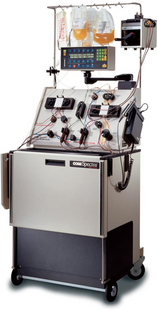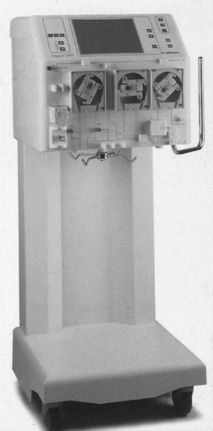PROCEDURE 116 • Therapeutic apheresis (i.e., hemapheresis) is a technique for selective removal of cells, plasma, and substances from the patient’s circulation to promote clinical improvement. The different apheresis techniques vary according to the component of the blood removed or replaced or the substance removed. • During plasma exchange procedures, the plasma removed must be replaced; the most common replacement fluids are albumin, fresh frozen plasma (FFP), thawed plasma (derived from thawed FFP and maintained at low temperatures for use within 1 to 5 days), and normal saline.1 Because clotting factors are transiently reduced by plasma exchange, FFP can also be used as a fluid replacement in patients when bleeding is an issue. • Plasma volume is an estimate of the patient’s total volume based on gender, height, weight, and hematocrit value. Exchange volume is the ratio of the patient’s plasma volume to be removed and replaced; this is usually 1:1 or 1.5:1 of the patient’s estimated plasma volume.4 • In plasma exchange, an average of 3 to 5 L of plasma is removed and replaced.4 • Treatments can be done with two different machines.4 • Treatment length and frequency vary according to the disease being treated, rate of production of the substance being removed, and the patient’s response to treatment. Acute conditions, such as thrombotic thrombocytopenia purpura or graft-versus-host disease, usually require daily treatments for 5 to 7 days.6,7 Other conditions usually require plasma exchanges two or three times weekly for up to 6 weeks.2,5–7 The total amount of plasma to be exchanged is used as a guide for treatment. A single treatment, referred to as a plasma exchange, usually takes 2 to 3 hours with a centrifugal machine and 2 to 6 hours with filtration methods.4 • Apheresis procedures are performed by healthcare professionals such as registered nurses or blood bank personnel, with special knowledge and skills in apheresis. These procedures are commonly performed both in critical care units and on an outpatient basis, depending on the type of disease being treated and on the patient’s condition. • The most commonly used apheresis systems use two large-bore peripheral venous catheters, a double-lumen vascular access catheter (VAC), or a dialysis graft or fistula to access the vascular system. Peripherally inserted central venous catheters or implantable venous access ports do not provide for adequate blood flow and are not acceptable for use.4 • The system should be primed with an anticoagulant (e.g., heparin or citrate) to prevent clotting. If citrate is used, the patient must be monitored closely for hypocalcemia. Citrate works as an anticoagulant by binding calcium (Ca++), therefore decreasing the amount of Ca++ available for normal clotting.4 • Plasma exchange is used to treat antibody-mediated disorders because the pathogenic antibodies are contained in the plasma. Removal of these antibodies through plasma exchange reduces the number of circulating antibodies, temporarily decreasing the patient’s symptoms.
Apheresis and Therapeutic Plasma Exchange (Assist)
PREREQUISITE NURSING KNOWLEDGE
 Plasma exchange is the process of replacing the plasma removed with an equal amount of either plasma or fluid (most commonly a combination of 5% albumin and normal saline solution).
Plasma exchange is the process of replacing the plasma removed with an equal amount of either plasma or fluid (most commonly a combination of 5% albumin and normal saline solution).
 Cytapheresis is the selective removal of the cellular components of blood. Blood is withdrawn from the patient and a specific cellular component is retained (i.e., white blood cell); the remainder of other cells and plasma is returned to the donor or patient.
Cytapheresis is the selective removal of the cellular components of blood. Blood is withdrawn from the patient and a specific cellular component is retained (i.e., white blood cell); the remainder of other cells and plasma is returned to the donor or patient.
 Leukocytapheresis is the removal of white blood cells from the blood; the remaining blood is returned to the patient. It is most commonly used as a therapeutic method for blast cell reduction in leukemias (leukocytosis).
Leukocytapheresis is the removal of white blood cells from the blood; the remaining blood is returned to the patient. It is most commonly used as a therapeutic method for blast cell reduction in leukemias (leukocytosis).
 Erythrocytapheresis is the process of removing erythrocytes (red blood cells) from whole blood.
Erythrocytapheresis is the process of removing erythrocytes (red blood cells) from whole blood.
 Thrombocytapheresis is the selective removal of platelets (thrombocytes).
Thrombocytapheresis is the selective removal of platelets (thrombocytes).
 Plasma adsorption/perfusion is the removal of plasma with a hollow fiber filter. Blood is returned to the patient, and the plasma is pumped over an adsorptive column that removes certain proteins or pathogens. The treated plasma is then returned to the patient.
Plasma adsorption/perfusion is the removal of plasma with a hollow fiber filter. Blood is returned to the patient, and the plasma is pumped over an adsorptive column that removes certain proteins or pathogens. The treated plasma is then returned to the patient.
 Lymphoplasmaphersis is the separation and removal of lymphocytes and plasma from the withdrawn blood, with the remainder of the blood retransfused into the donor.
Lymphoplasmaphersis is the separation and removal of lymphocytes and plasma from the withdrawn blood, with the remainder of the blood retransfused into the donor.
 Immunoadsorption is the removal of an antigen in the blood by a specific antibody lining the surface of a filter or cartridge.
Immunoadsorption is the removal of an antigen in the blood by a specific antibody lining the surface of a filter or cartridge.
 Photopheresis uses apheresis techniques to remove and return blood to the patient. Photosensitizing drugs are given to the patient, and white blood cells are removed and exposed to an ultraviolet light, then returned to the patient. Photopheresis induces cellular changes that have been shown to be effective in certain diseases such as cutaneous T-cell, graft-versus-host disease, post–bone marrow transplant, and solid organ transplant rejection. Apheresis techniques are also used for the procurement of peripheral stem cells for bone marrow transplantation.
Photopheresis uses apheresis techniques to remove and return blood to the patient. Photosensitizing drugs are given to the patient, and white blood cells are removed and exposed to an ultraviolet light, then returned to the patient. Photopheresis induces cellular changes that have been shown to be effective in certain diseases such as cutaneous T-cell, graft-versus-host disease, post–bone marrow transplant, and solid organ transplant rejection. Apheresis techniques are also used for the procurement of peripheral stem cells for bone marrow transplantation.
 Centrifugal apheresis machine: Separates plasma and other blood components with use of a centrifuge (Fig. 116-1).
Centrifugal apheresis machine: Separates plasma and other blood components with use of a centrifuge (Fig. 116-1).
 Filtration: A hollow-fiber cell separator, permeable to plasma proteins, is used to remove the patient’s plasma via an apheresis machine or continuous renal replacement machines adapted for pheresis (Fig. 116-2).
Filtration: A hollow-fiber cell separator, permeable to plasma proteins, is used to remove the patient’s plasma via an apheresis machine or continuous renal replacement machines adapted for pheresis (Fig. 116-2).

Full access? Get Clinical Tree


116: Apheresis and Therapeutic Plasma Exchange (Assist)


